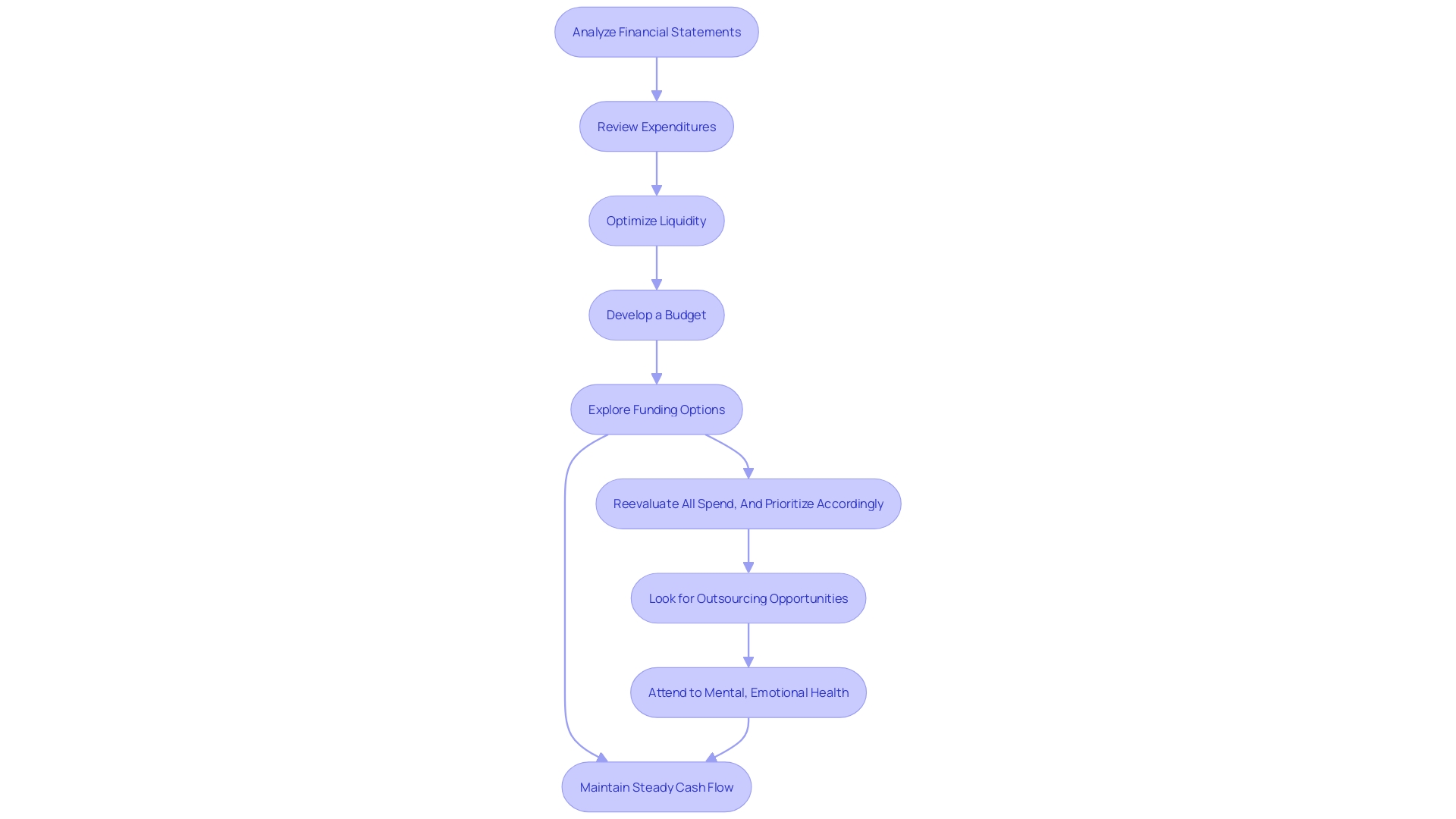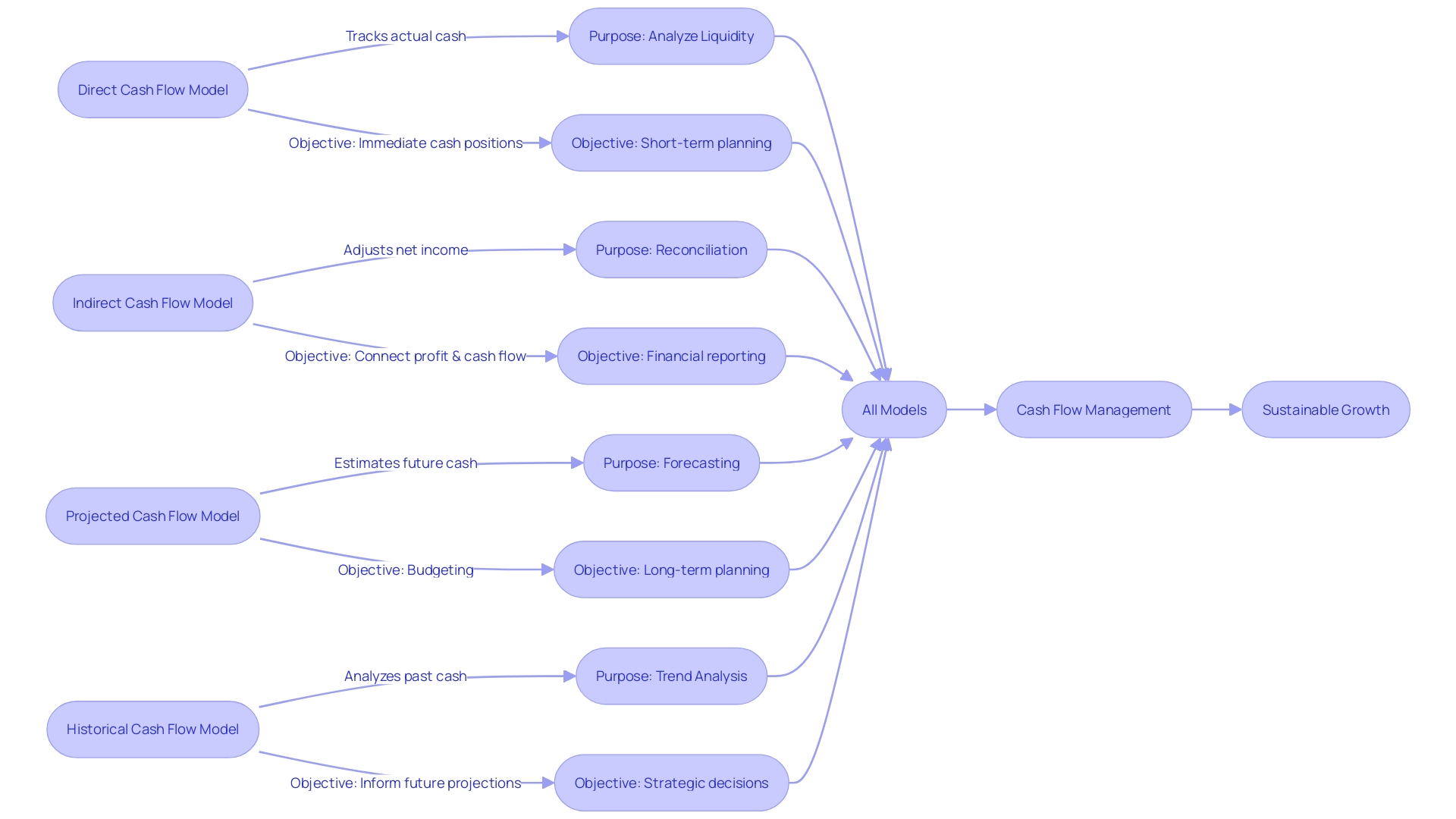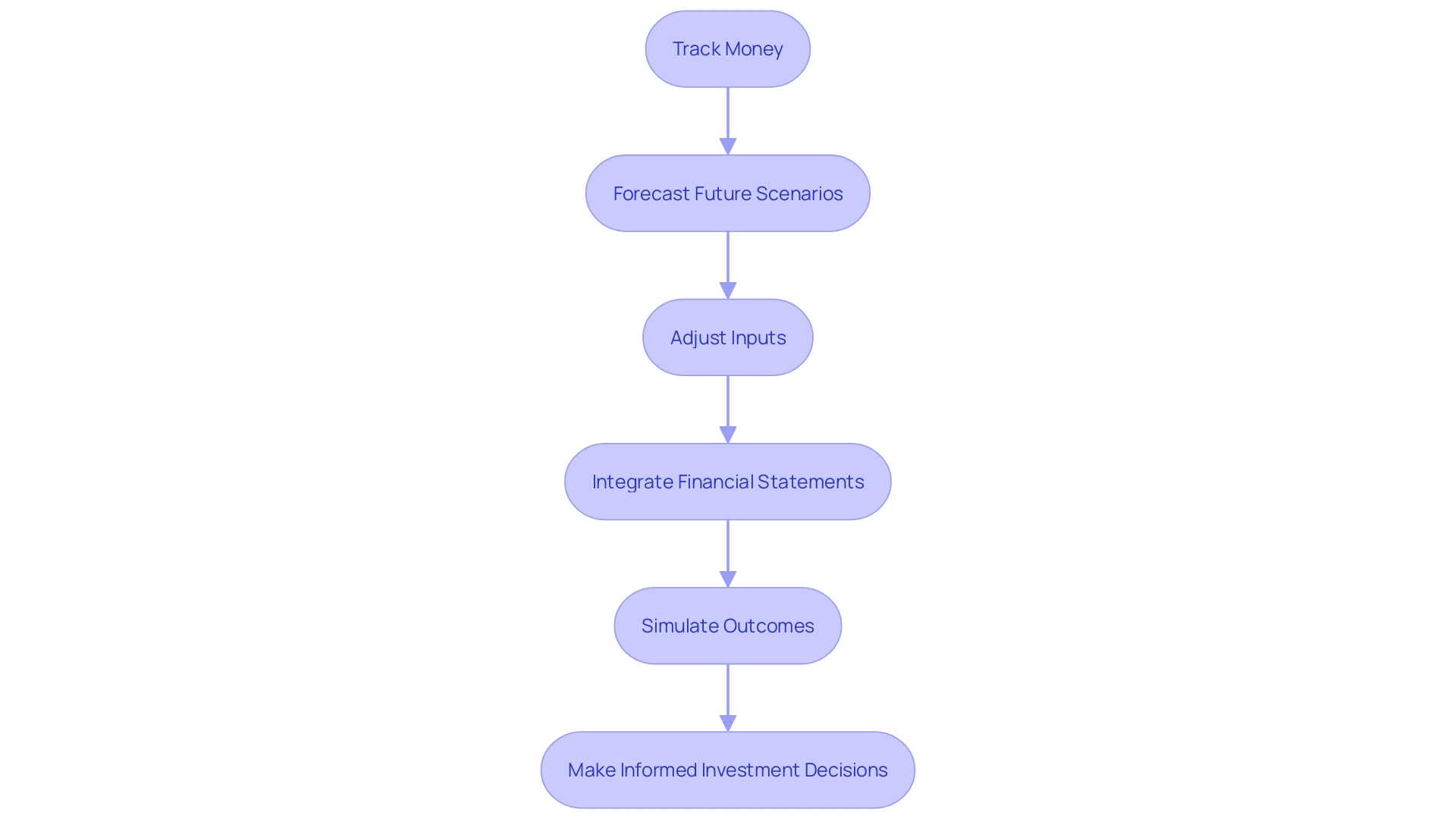Introduction
Cash flow modeling is a strategic tool that goes beyond financial prediction, providing crucial insights into the liquidity of an organization. By incorporating variables such as sales, expenses, investments, and funding activities, this model serves as a financial compass, illuminating the pathways cash takes within a company. Understanding the synergy between the cash flow statement, income statement, and balance sheet is essential for effective cash flow management.
To avoid cash shortages and ensure prosperity, businesses must wield cash flow modeling as both shield and spear. In this article, we will explore the importance of cash flow modeling, different types of cash flow models, steps to create a robust cash flow model, tools and software for cash flow modeling, common challenges, best practices, case studies, and additional resources to fortify your organization's financial acumen. Whether you're a CFO or a financial executive, this article will equip you with practical advice and solutions to navigate financial waters prudently and drive the long-term success of your enterprise.
What is Cash Flow Modeling?
Cash flow modeling transcends mere financial prediction; it's a strategic tool for analyzing the liquidity heartbeat of an organization. By incorporating variables such as sales, operational expenses, capital investments, and funding activities, this model serves as a financial compass. Its principal aim?
To illuminate the pathways cash takes within a company, equipping executives with the foresight needed to navigate financial waters prudently.
Missteps in cash flow management often stem from an oversight of the synergy between the cash flow statement, income statement, and balance sheet. These documents are the financial trifecta offering insights into revenue, expenditures, profitability, and indebtedness. Dr. Sharon H. Porter from Vision & Purpose Lifestyle Magazine and Media emphasizes the imperative of leaders to "Know your numbers!"
for the enduring success of their enterprises.
- "You understand that managing your finances can be challenging when running a business. One key factor in generating long-term, sustainable profits for your business is to master cash flow." - Dr. Sharon H. Porter
A growth model, often materialized in spreadsheet form, translates business equations into an analytical framework. This powerful mechanism dissects business dynamics and directs resource allocation to fuel growth. However, the underutilization of such models can undercut their potential.
Evidently, maintaining operational thrift is paramount. Fixed costs should be subjected to the question, "Is there a flexible way to adjust costs according to your revenue and business needs?" as a measure to tether expenses to actual business performance.
In the realm of operational efficiency, AI emerges as a critical ally. Reports show industries at the forefront of operational efficiency discussions, such as software, healthcare, and financial services, are also those most engaged with AI integration. The implication is clear: investing in technology is not merely about cost containment but also about sowing the seeds for future productivity gains.
JPMorgan's foray into AI with their Cash Flow Intelligence tool underscores the importance of predictive cash flow analysis. The tool's adoption by 2,500 clients within a year of launch demonstrates a burgeoning demand for solutions that not only offer foresight into cash movements but also promise enhanced decision-making capabilities.
Understanding the distinction between cash flow and profit is a cornerstone of business acumen. While both are vital indicators of financial health, cash flow is the rhythm of financial inflows and outflows, acting as the lifeline for operational sustenance and strategic ventures. To avert the perils of cash shortages and ensure prosperity, a business must wield cash flow management as both shield and spear.

Importance of Cash Flow Modeling
Robust cash flow modeling is indispensable for the vitality of a business, serving as a navigational tool for financial foresight. It illuminates the financial path ahead, revealing periods of cash abundance or deficiency, thereby empowering businesses to act preemptively. With an astute cash flow forecast, companies can bridge funding gaps preemptively and scrutinize the feasibility of investments under various circumstances, thus guiding strategic decision-making with a well-analyzed cash flow projection.
Understanding the intricate dance of cash coming in and out—a concept distinct from profit—is fundamental to business efficiency and informed decision-making. The cash flow statement, along with the income statement and balance sheet, provides a comprehensive picture of financial health. Dr. Sharon H. Porter emphasizes the necessity of familiarity with these statements for successful business leadership.
The fluidity of financial modeling, such as the Three Statement Model and the Discounted Cash Flow Model, lies in their adaptability. As business landscapes evolve, these models can be recalibrated with current data to yield fresh insights, ensuring continuous alignment with the company's trajectory.
A salient lesson from SpaceX's journey underscores the significance of navigating through phases of negative cash flow to reach financial viability. The company's strategic cash flow management enabled it to turn a profit, exemplifying the power of dynamic financial planning.
In essence, cash flow mastery is a strategic imperative—not just for survival but for the flourishing of a business. It requires a keen understanding of cash flow versus profit, strategic planning, and the agility to adapt financial models as circumstances demand. This holistic approach to cash flow management is the cornerstone of a resilient and prosperous enterprise.

Types of Cash Flow Models
Organizations have a range of cash flow models at their disposal, each serving distinct purposes and objectives. The Direct Cash Flow Model zeroes in on the immediate cash transactions related to a business's primary operations. In contrast, the Indirect Cash Flow Model begins with net income and factors in non-cash transactions and working capital variations to calculate cash flow.
For future-oriented planning, the Projected Cash Flow Model is invaluable, as it helps predict cash movement for specific projects, aiding in assessing their economic viability. Lastly, the Historical Cash Flow Model allows businesses to analyze past cash flow data, uncovering trends that can shape informed future forecasts.
Selecting the right cash flow model is a strategic decision. It should align with the company's industry, size, and unique needs. For instance, direct-to-consumer (D2C) or software-as-a-service (SaaS) companies might find one comprehensive model sufficient, while more intricate businesses, such as marketplaces, might require a more complex approach to avoid the pitfalls of oversimplification.
Bain research underscores the rarity of unicorns—firms valued over $1 billion—that are cash-flow positive on their own, highlighting the criticality of robust cash flow management for sustainable growth without constant capital infusions.
Cash flow management's importance cannot be overstated: it's the lifeblood of any business, allowing it to meet expenses, invest strategically, and expand. A study indicated that even in today's market, where unicorns are more common, only a select few can generate significant operational cash flow. This reality emphasizes the imperative for meticulous cash flow modeling to avoid the dire consequences of cash shortages, which can spell disaster for seemingly prosperous businesses.

Steps to Create a Cash Flow Model
Creating a robust cash flow model is a dynamic and ongoing endeavor, essential for any business aiming to secure financial stability and growth. To craft a precise and reliable cash flow projection, follow these critical steps:
-
Objective Definition: Start by pinpointing the exact purpose of the cash flow model. Are you looking to evaluate project feasibility, secure financing, or enhance operational budgeting? Clarity on the model's objective sets the stage for focused analysis.
-
Data Collection: Diligently compile all pertinent financial records: historical cash flows, income statements, balance sheets, and more. Accurate data serves as the bedrock of trustworthy projections.
-
Future Cash Flow Estimation: Utilize the collected data as a springboard to forecast future cash movements. Incorporate sales projections, anticipated expenses, capital investments, and financial activities, molding a forward-looking financial narrative.
-
Discounted Cash Flow (DCF) Analysis: Integrate the time value of money by discounting future cash flows to their present value. This nuanced approach aids in appraising potential investments, weighing their financial merit.
-
Results Analysis: With a complete cash flow model in hand, meticulously examine the output. Search for hidden risks, untapped opportunities, and areas demanding attention, turning insights into actionable strategies.
Remember, a well-structured cash flow model isn't just a static document; it's a vital tool that adapts as your business evolves. Whether you're running a budding eCommerce platform with its low overheads and global reach or a consulting firm with stable, ongoing revenue streams, the key lies in regular updates and clear, transparent assumptions.
For instance, the Three Statement Model, which incorporates income statements, cash flows, and balance sheets, is a fundamental yet powerful framework that can illuminate a company's financial trajectory. Similarly, businesses that consistently generate positive operational cash flows are signaling their capacity to thrive without external financing.
As you navigate through the complexities of cash flow management, remember that a business's lifeblood is its ability to manage the ebb and flow of funds. In the words of financial experts, "Cash is queen in the business world," and mastering cash flow management equates to steering your business towards long-term prosperity and resilience.
Tools and Software for Cash Flow Modeling
To optimize their financial operations, businesses have a variety of resources at their disposal for creating and analyzing cash flow models. Tapping into these resources can significantly improve the precision of cash flow predictions and the efficiency of financial planning processes. Here's a closer look at the most effective tools:
-
Spreadsheet Software: Platforms such as Microsoft Excel and Google Sheets are widely embraced for their versatility and user-friendly interface. They serve as a foundational tool for constructing cash flow models, enabling users to manually enter data and utilize built-in formulas for analysis.
-
Financial Planning and Analysis Software: These solutions excel in delivering an advanced suite of financial modeling tools. They facilitate the creation of intricate cash flow models and support thorough analysis, which can be pivotal for companies aiming to make informed strategic decisions.
-
Cash Flow Management Software: Designed with a focus on forecasting and managing cash flows, these applications provide functionalities like scenario planning, visual representation of cash flow, and seamless integration of financial data, which can streamline the forecasting process.
When selecting the right tool, companies must consider their specific needs, the complexity of their financial operations, and their budget to ensure the chosen solution aligns with their objectives and enhances their cash flow modeling capabilities.
Real-world applications of these tools can be seen in companies like Citizens Financial Group, Inc., which manages its extensive portfolio of financial services through meticulous cash flow analysis. Similarly, businesses that operate critical on-premise infrastructure, such as those releasing software updates in large batches, benefit from robust financial planning tools to synchronize product releases with financial targets. Monte Carlo Simulations, for instance, are employed to forecast completion dates and manage product delivery, which can include physical shipping to remote locations.
The necessity for precise cash flow modeling is further underscored by the shift in consumer payment behaviors post-pandemic, as reported in the Diary of Consumer Payment Choice. With an ongoing preference for credit cards over cash, businesses must adapt their financial strategies to accommodate these changes, making reliable forecasting tools an indispensable asset.
Common Challenges and Best Practices
Crafting a robust cash flow model is crucial for any business aiming to navigate the complexities of financial planning effectively. However, it's not without its hurdles. Precision in data is paramount.
Establishing stringent data collection and validation methods is essential to minimize inaccuracies, ensuring that your cash flow model stands on a solid foundation of reliable information.
In the realm of cash flow modeling, assumptions and variable estimates are inevitable. Yet, it's imperative to meticulously document these conjectures and continually reassess and adjust them in response to market fluctuations. By doing so, you can maintain the relevancy and precision of your cash flow projections.
Another critical aspect is sensitivity analysis. This involves examining how changes in key variables might affect cash flow forecasts, thus enabling companies to quantify the risks attached to different financial scenarios.
To surpass these challenges and fortify your cash flow modeling, consider adopting the following best practices:
- Regular Monitoring and Review:
It's essential to continuously monitor and revise your cash flow models. This not only involves integrating actual data into the model for comparison with projections but also reassessing the model's parameters to ensure they remain meaningful.
- Collaboration and Communication:
Effective cash flow modeling is not a solo endeavor. It requires the collaborative efforts of finance teams, department leaders, and other relevant stakeholders. Open and clear communication is vital to ensure that everyone involved has a comprehensive understanding of the model and the financial implications it carries.
- Continuous Improvement:
Cash flow modeling is inherently iterative. Organizations should be unceasing in their quest to enhance their models. This can be achieved by incorporating feedback, refining assumptions, and embracing new methodologies or technological tools that emerge in the financial sector.
By embracing these practices, organizations can significantly improve their cash flow modeling process, which is a vital component of strategic financial planning and management.

Case Studies and Examples
Cash flow modeling has proven to be an essential tool for businesses aiming to enhance their financial decision-making processes. For instance, a manufacturing enterprise, referred to as Company A, adeptly utilized cash flow modeling to scrutinize the potential outcomes of increasing their production capabilities. This strategic approach allowed them to evaluate how such an expansion would influence their cash flows, profitability, and investment returns.
Similarly, Company B, operating in the retail sector, employed this financial modeling to anticipate cash flow deficits during their slower sales periods. Their proactive planning enabled them to arrange for additional financing and implement cost-saving strategies, effectively diminishing the potential adverse effects on their operations.
These examples underscore the versatility of cash flow modeling in different business contexts. By simulating various scenarios, companies can better prepare for the future, ensuring that they have the necessary strategies in place to maintain a robust financial position.
The adaptability of financial modeling is further highlighted by the Three Statement Model, which integrates income statements, cash flows, and balance sheets. This model serves as a fundamental tool for businesses to continuously update their financial outlook as market conditions evolve.
Moreover, the significance of cash flow management is echoed in the insights of industry experts who emphasize the importance of mastering the flow of money within a business to ensure long-term sustainability. This becomes even more critical as recent studies reveal that a significant portion of small and medium-sized enterprises continue to rely on manual processes for managing their cash flows, leading to challenges in tracking financial performance and generating accurate forecasts.
By embracing advanced financial modeling and technology solutions, companies can overcome these challenges, driving productivity and creating operational efficiencies. As such, the implementation of cash flow modeling is not only a practice for current financial assessment but also a strategic asset for future growth and success.

Additional Resources
To fortify your organization's financial acumen, particularly in cash flow modeling, it's advantageous to delve into a variety of educational materials and avenues for growth. Consider 'Financial Modeling' by Simon Benninga, a seminal text that provides detailed guidance on constructing financial models. Simultaneously, 'Principles of Cash Flow Valuation' by Joseph Tham and Ignacio Velez-Pareja offers a deep dive into the nuances of cash flow analysis, a crucial skill in assessing the health and prognosis of your business.
In the digital learning sphere, platforms such as Coursera and Udemy stand as beacons for those seeking to expand their knowledge. They offer comprehensive courses that take you through the intricacies of financial modeling and cash flow analysis, allowing you to apply these skills directly to your organization's financial strategy.
Furthermore, engaging with industry associations and professional finance networks can be an invaluable resource. These communities provide access to a wealth of industry-specific knowledge, facilitate connections with thought leaders, and offer insights into best practices in financial management. By tapping into these resources, you can enhance not only your understanding but also the financial robustness of your enterprise, safeguarding against cash shortages and positioning for sustainable growth.
Conclusion
In conclusion, robust cash flow modeling is crucial for effective financial management and strategic decision-making. By incorporating variables such as sales, expenses, investments, and funding activities, cash flow models provide crucial insights into the liquidity of an organization. Understanding the synergy between the cash flow statement, income statement, and balance sheet is essential for cash flow management.
Cash flow modeling enables businesses to bridge funding gaps, assess investment feasibility, and make informed strategic decisions. Different types of cash flow models serve distinct purposes, such as the Direct Cash Flow Model, Indirect Cash Flow Model, Projected Cash Flow Model, and Historical Cash Flow Model.
Creating a precise cash flow model involves defining objectives, collecting accurate data, estimating future cash flows, conducting discounted cash flow analysis, and analyzing the results. Regular monitoring, collaboration, and continuous improvement are vital best practices.
To optimize financial operations, businesses can leverage tools like spreadsheet software, financial planning and analysis software, and cash flow management software. These tools enhance the precision of cash flow predictions and streamline the forecasting process.
Crafting a robust cash flow model requires precision in data collection, reassessment of assumptions, and sensitivity analysis to quantify risks. Case studies highlight the versatility of cash flow modeling in evaluating strategic decisions and anticipating cash flow deficits.
To fortify financial acumen in cash flow modeling, educational resources and online learning platforms offer guidance. Engaging with industry associations and professional finance networks provides access to industry-specific knowledge and best practices.
In conclusion, robust cash flow modeling is a strategic imperative for businesses. It guides financial decision-making, helps bridge funding gaps, and ensures long-term success. By mastering cash flow management, businesses can navigate financial waters prudently and drive growth.




